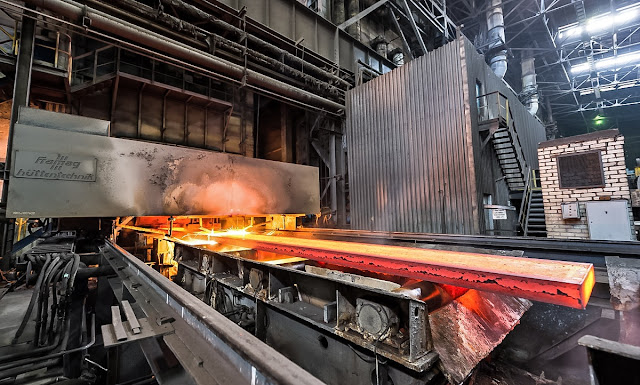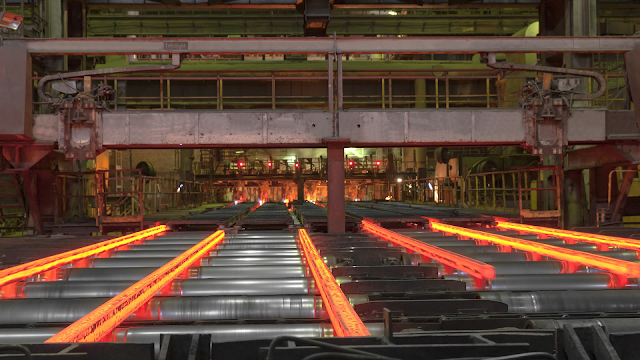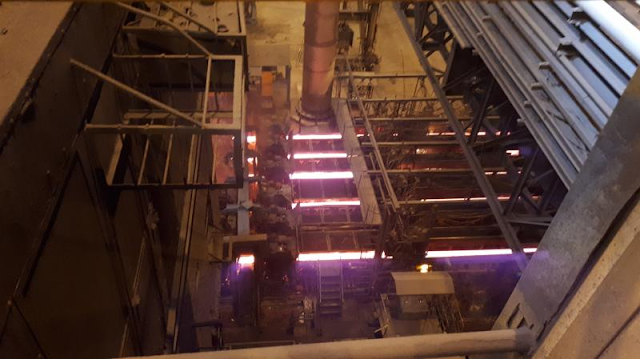In 1997, POSCO and Hitachi jointly started to develop a new endless rolling process of strip steel with shearing and welding process for intermediate billet connection. In April 1998, Nippon Steel Co., Ltd. successfully developed a steel plate endless rolling production line using a high-energy laser to realize butt welding of the intermediate slab. From 2006 to 2007, POSCO and Hitachi put into industrial production the new endless rolling process of strip steel with intermediate billet connection by shear and welding process. Based on the pendulum shear concept, this new solid-state connection process realized the innovation of endless rolling connection technology. In 2009, the world's first ESP endless casting and rolling strip steel production line jointly built by Italian steel enterprise Arvedi and Siemens was put into operation, with an output of 450000 tons.
Taking Arvedi ESP line as an example, this paper briefly introduces the process characteristics and technical advantages of endless continuous casting and rolling of strip steel.
1. ESP Process and Main Features
(1) Introduction of ESP Process
Arvedi ESP production line is shown below. The technology is developed on the basis of Demark's ISP technology. The continuous caster in the production line adopts parallel plate straight arc mold, and the slab guide adopts a casting rolling structure. The slab is directly rolled into the blooming mill through liquid core reduction, and then can be sold off the production line after shearing. The slab without production line is heated by induction, and the strip steel is rolled into thin strips by five finishing mills and then rolled into coils after cooling. The ESP production line is the shortest continuous casting and rolling production line in the world with a total length of only 190m.
(2) Main Technical Features of ESP Process
① Higher casting speed.
Higher casting speed can be achieved by optimizing caster configuration and increasing flexibility of thickness and casting speed. Through the mathematical simulation of the computer optimized hydrodynamic calculation and (physical) water model test, it shows that the current pouring speed of 5-6 M / min can still be greatly improved.
② Stable casting process control.
In the past decade, the most significant improvements have been made in the stability control of slab forming and slab solidification, and the mold fluxes required for different steel grades have also been optimized. Stable control at high casting speed has been achieved by controlling friction and mold angle arrangement.
③ Wide application of automation technology.
The key to success lies in the improvement of technological process control, sensor technology, data management and process. In the thickness control, temperature control, plate shape control and flatness control of Siemens VAI products, the central network strengthens the flexibility and standardization of the process model. For example, the "microstructure target cooling" package can control the metallurgical parameters of strip steel. In the ESP line, automation runs through the whole process from self-casting to cooling.
2. Main advantages of ESP process
(1) Technical Advantages
① The ESP production line is the first one that can complete the hot strip rolling from molten steel to underground coiler in 7 minutes, while the original ISP thin slab continuous casting and rolling production line takes 15 minutes from molten steel casting to finished strip production;
② ESP technology is rolled at high temperature, which improves the uniformity of microstructure and improves the performance of products;
③ The whole production line is not more than 190m from the beginning of continuous casting to the coiler of finished product, which is very compact and belongs to the ultra-short process. The investment of equipment and plant is reduced, and the yield is relatively improved. The endless strip production process avoids the threading of the new coil in the finishing mill, so the thin (0.8-1.0 mm) coil can be produced safely and reliably. It is estimated that the yield of steel from molten steel to coil can reach 98.0% - 98.5%, while ISP process is only 96.5%;
④ It can produce high-quality ultra-thin strip steel, some of which can replace cold-rolled products and directly carry out pickling and galvanizing;
⑤ In the aspect of energy-saving and environmental protection, ESP technology can make full use of the high-temperature energy of continuous casting slab at high temperature, even if the larger reduction is implemented, the rolling force is also lower.
Compared with conventional hot strip mill, 2-3 reheating furnaces are reduced; Compared with CSP thin slab continuous casting and rolling, more than 200 meters long tunnel furnace is also reduced. And rolling at high temperatures greatly reduces the power of the rolling mill and the power consumption. Compared with ISP process, the Cremona furnace is canceled, but the power of the induction furnace is increased. The maximum power of ISP induction furnace is 20MW, and that of the ESP induction furnace is 36mw.
In addition, ESP is different from other thin slabs continuous casting and rolling processes in that it only needs little energy to improve the capacity and efficiency of the production line. At the ultimate drawing speed, i.e. 7.6m/min (70mm for blank) × 1250mm) and 8.3m/min (55mm for blank) × The energy input of the induction heater will be reduced to zero. The energy consumption of ESP is about 25% - 30% less than ISP and 40% less than traditional hot strip mill. Related to the reduction of energy consumption is the direct or indirect reduction of greenhouse gas and harmful gas emissions, which is reduced by 40% - 50% in the production of general specifications and 65% - 70% in the production of thinner specifications. In terms of water consumption, its water consumption is 80% lower than that of the best traditional production method.
(2) Advantage of Variety Structure
① Full range of steel grades
The product outline of ESP line design is a complete product range from low carbon steel to high carbon steel, as well as alloy steel, including high-grade and high-quality steel grades (such as oriented and nonoriented silicon steel, if the steel used to manufacture automobile body panels). Using ArvediESP equipment, hot-rolled products with cold rolling surface quality (Grade A) can be produced (which can be directly used for manufacturing bare parts of the automobile); Hot rolled products with the characteristics of IF steel can also be produced from converter molten steel.
② Thin specification products.
The endless rolling technology is adopted in the ESP process to reduce the number of threading. Therefore, the Arvedi ESP process can be used to produce a large number of hot-rolled products with thin specifications (thickness 0.8-1.0 mm) and Arvedi patent rights, which can replace cold-rolled products in many fields, including steel grades with yield limit of 315 MPa and thickness of 1 mm; The yield limit is 420MPa and the thickness is 1.25mm; High strength steel with thickness less than 2mm (strength 700-800mpa); Dp600-dp1000 steel with the thickness of 1.2-1.5mm can replace some cold-rolled products and increase the added value of products.
(3) Cost Advantage
ESP production line has excellent process cost advantage because it adopts endless continuous casting and rolling process and compact short process. According to the analysis [3-5], the process cost of the ESP process is about 55% of that of the traditional process, about 70% of that of other thin slab processes, and about 77% of that of the ISP process. It can be concluded that the overall product outline of ESP process is expected to have a metal yield of 98%, which is about 30% - 50% lower than that of the traditional hot strip production process. Compared with the twin-roll strip casting and rolling process, the ESP process has a good comprehensive competitive advantage and is a new process worthy of attention and expectation.
In a word, the first production line invested by Arvedi has proved the advantages of the ESP process. ESP is representative of an energy-saving and consumption-reducing environment-friendly production line. In the future, the iron and steel industry will continue to develop in the direction of energy-saving and environmental protection, high production efficiency and low consumption, and high product quality, this process has gradually highlighted its strong competitive advantages.
Provide complete solutions for Hot and Cold Rolling Mills, which includes, planning, consultancy, design, manufacturing, and commissioning of the plant. Email: marketing2@hanrm.com
More Articles You May Be Interested in:





Extremely useful information which you have shared here about mig welding machine...... This is a great way to enhance knowledge for us, and also beneficial for us. Thank you for sharing an article like this.
ReplyDeletehello ,
ReplyDeletei am nishith mangal from V.p.Technnical
i am interest to Endless Continuous Casting and Rolling (ESP) Technology adopted. kindlly shear the contact and mythology required details with tentative project cost .
from
Nishith Mangal , VICE PRASIDENT PROJECT (ROLLING & BAR MILL )
nishithmangal@gmail.com 91-8249936883
hello ,
ReplyDeletei am nishith mangal from Vice President
i am interest to Endless Continuous Casting and Rolling (ESP) Technology adopted. kindly shear the contact and mythology required details with tentative project cost .
from
Nishith Mangal , VICE PRASIDENT PROJECT (ROLLING & BAR MILL )
nishithmangal@gmail.com 91-8249936883
ReplyDeleteIt was such a good post. Visit Super Duplex Plate Supplier. Thanks for sharing.